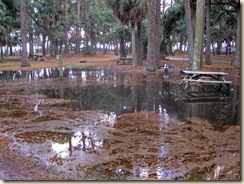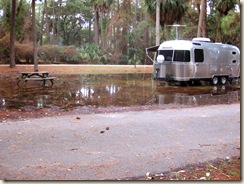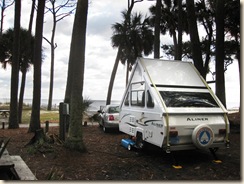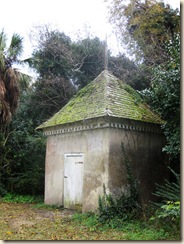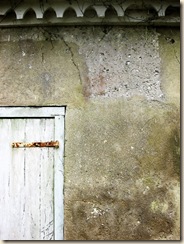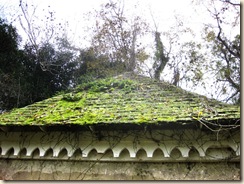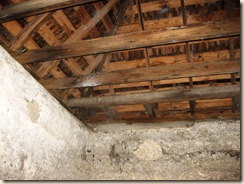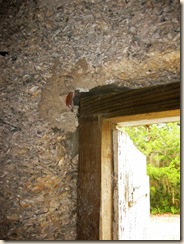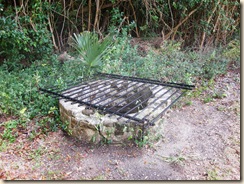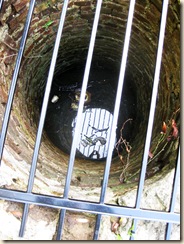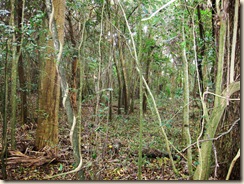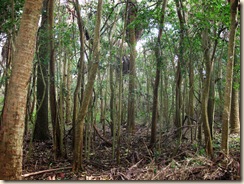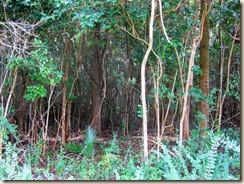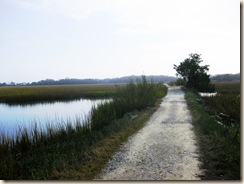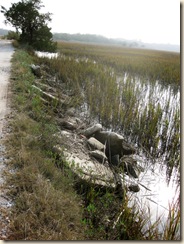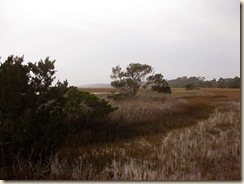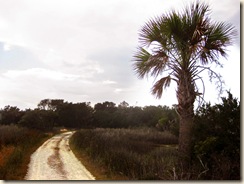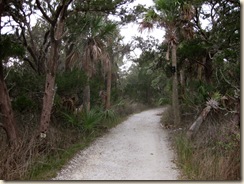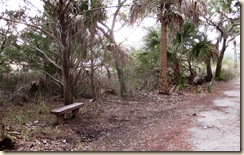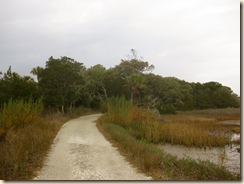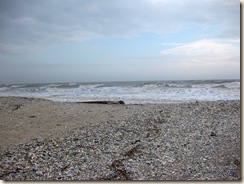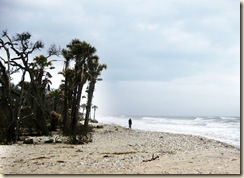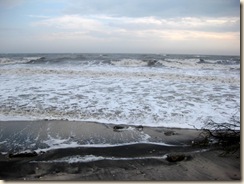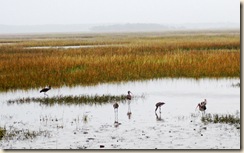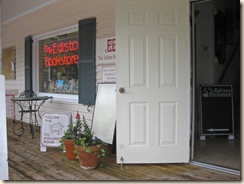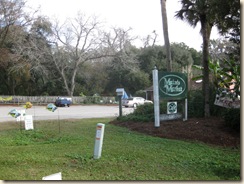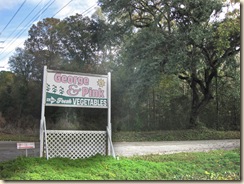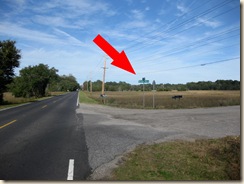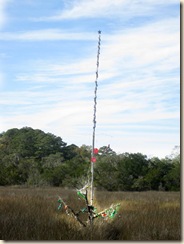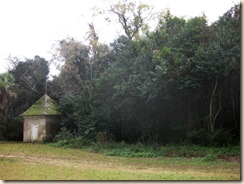Click here for the first post in this series.
Standing water here is nearly all gone, as we expected. And weather has warmed a little. But nowhere near what it would take to coax me out onto the water in the Advanced Elements kayak. Which, at any rate, is at home.
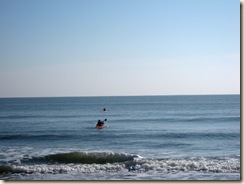 Two women camped in tents across the road proved far more adventurous. Tent camping at this time of year is adventurous enough. But above you see one of them punching through the waves directly in front of the Aliner. And the other well out beyond the surf.
Two women camped in tents across the road proved far more adventurous. Tent camping at this time of year is adventurous enough. But above you see one of them punching through the waves directly in front of the Aliner. And the other well out beyond the surf.
Ah, it’s tempting …. But they appear to be much more experienced, and they’re certainly better equipped! That’s my excuse, anyway.
Instead of venturing off in the kayak, I drove back over to Beaufort today. For a general look around and a horse carriage tour of the Historic District.
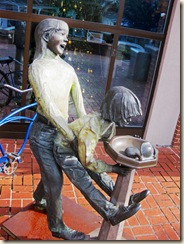 First, though, a detour to the Beaufort County Public Library. Above is a snap of the nice sculpture at the Library’s front entrance. It’s entitled “Helping Hands,” and is the work of Norman Mannson.
First, though, a detour to the Beaufort County Public Library. Above is a snap of the nice sculpture at the Library’s front entrance. It’s entitled “Helping Hands,” and is the work of Norman Mannson.
At the Library I met Mr. Dennis Adams, author of the article on Tabby mentioned in an earlier post, and dozens of other Low Country topics over the years. And visited the South Carolina History Room, where Ms. Seabrook helped me find sources that might be of interest.
Everyone at the Beaufort Library was most helpful and generous with their time. But it’s clear that I’m searching for information on the illusive Oqui and his garden in the wrong place. The libraries and historical societies in Charleston are more likely to have any materials available. So, on to Charleston in the not too distant future. Stay tuned.
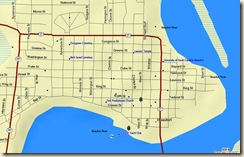 Beaufort is an incredible place. There’s so much to see, and so much to learn, that it’s impossible to offer even a superficial treatment of the whole town with just a few paragraphs and photos. Again, you’ll have to experience it for yourself.
Beaufort is an incredible place. There’s so much to see, and so much to learn, that it’s impossible to offer even a superficial treatment of the whole town with just a few paragraphs and photos. Again, you’ll have to experience it for yourself.
The town was preserved from destruction during the 1860s Unpleasantness by occupation of Union troops throughout the War. Immediately after news of the defeat of Confederate forces at Port Royal reached Beaufort, the white population fled in what has become known as The Great Skedaddle. Leaving houses, property, and even food on the table, in some cases. More on this in a later post.
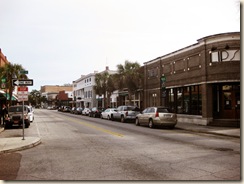 Well, where does one start? Usually by parking the car [there’s ample parking most everywhere] and walking up and down Bay Street a couple of times. That’s the southernmost street you see in the map above.
Well, where does one start? Usually by parking the car [there’s ample parking most everywhere] and walking up and down Bay Street a couple of times. That’s the southernmost street you see in the map above.
Lots of interesting shops, galleries, and even restaurants. Plenty to see. But don’t forget your wallet. This isn’t the bargain basement part of town! But neither is it “touristy,” in the negative sense of that term. Visitors certainly shop on Bay Street. But so do the locals.
So, have a look around. You’re bound to find something you simply can’t leave Beaufort without. The Bay Street Trading Company, by the way, offers an excellent selection of books on Beaufort and the surrounding area. Including hard-to-find historical treatments.
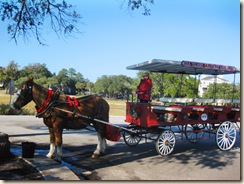 After the shops of Bay Street, an excellent way to get an informed overview of the historic section of Beaufort is by joining one of Walter Gay’s Sea Island Carriage Company tours. Here you see Ms. Debbie and Doc awaiting a new load of passengers.
After the shops of Bay Street, an excellent way to get an informed overview of the historic section of Beaufort is by joining one of Walter Gay’s Sea Island Carriage Company tours. Here you see Ms. Debbie and Doc awaiting a new load of passengers.
 Mr. Gay and his large family have lived in the Lowcountry all their lives. And for many generations. I spoke briefly with him about this latest enterprise as he passed by. He requires his tour guides to know what they’re talking about as they clop along Beaufort’s historic streets. Knowing how to handle a horse and carriage isn’t enough.
Mr. Gay and his large family have lived in the Lowcountry all their lives. And for many generations. I spoke briefly with him about this latest enterprise as he passed by. He requires his tour guides to know what they’re talking about as they clop along Beaufort’s historic streets. Knowing how to handle a horse and carriage isn’t enough.
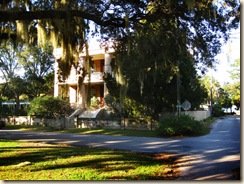 Mr. Gay agreed to do a recorded interview about Beaufort and the Sea Islands one of these days. Should be interesting! So stay tuned.
Mr. Gay agreed to do a recorded interview about Beaufort and the Sea Islands one of these days. Should be interesting! So stay tuned.
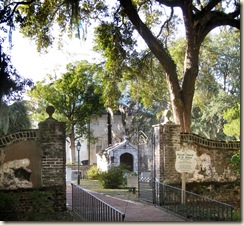 I was lucky to pick a tour conducted by Ms. Debbie. In a carriage pulled by “Doc.” You saw both of them in the photo above. Doc has an air of resigned docility that makes him ideal for his daily task. He’s seen it all!
I was lucky to pick a tour conducted by Ms. Debbie. In a carriage pulled by “Doc.” You saw both of them in the photo above. Doc has an air of resigned docility that makes him ideal for his daily task. He’s seen it all!
Doc pulled steadily and never hurried. Giving Ms. Debbie time to explain the background of the historic sites we passed, one after another, on Beaufort’s streets.
Then, about two-thirds of the way through the tour, we learned that Ms. Debbie actually lives in one of those historic houses. One that belonged to her grandmother. No wonder she knows so much about the the area! It was an enjoyable and informative tour.
That’s all we have time for today. The rest of Beaufort and its remarkable history will have to wait for another visit and other posts. So stay tuned.
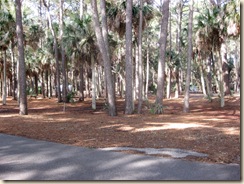


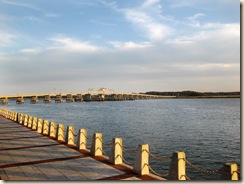

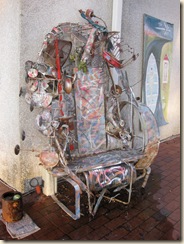
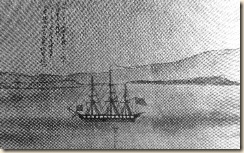 Morrison calls the Lexington an “old and notoriously slow corvette,” “now converted into a steamship.” Here above is a drawing of the Lexington made by a Japanese observer during Perry’s second visit to Japan. Old and slow it may have been. But it was the vessel of greatest interest here to us, since it carried our Oqui to the United States in 1855.
Morrison calls the Lexington an “old and notoriously slow corvette,” “now converted into a steamship.” Here above is a drawing of the Lexington made by a Japanese observer during Perry’s second visit to Japan. Old and slow it may have been. But it was the vessel of greatest interest here to us, since it carried our Oqui to the United States in 1855. 
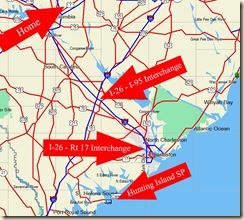 I’ve mentioned Route 17 before here, if memory serves. It has the disadvantage of quite regular construction projects here and there. But it’s far more interesting to drive. Both natural and social scenery abounds! And traffic is nowhere near as frenetic.
I’ve mentioned Route 17 before here, if memory serves. It has the disadvantage of quite regular construction projects here and there. But it’s far more interesting to drive. Both natural and social scenery abounds! And traffic is nowhere near as frenetic. 
